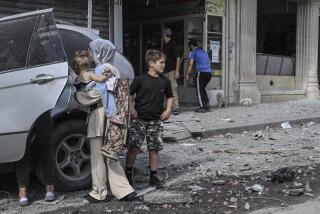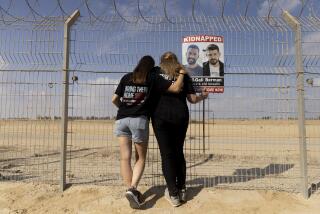The Threat of Annihilation Is Still Real
For 40 years, we have lived with a situation so bizarre it is almost beyond belief.
U.S. nuclear forces have been controlled by a “launch on warning” strategy. In order to reduce the number of our weapons that would be destroyed by a Russian first strike, our warheads stand ready to be launched while Russian warheads are in flight. No more than 15 minutes can elapse, under the policy, from the time of first warning of a Russian attack and the launching of our missiles, which means the president must evaluate the danger and decide whether or not to push the button with no time to study the situation.
To make that possible, the commander-in-chief of the U.S. Strategic Air Command carries with him a secure telephone, no matter where he goes, 24 hours a day, seven days a week, 365 days a year. This telephone is linked to the underground nuclear command post of the North American Aerospace Defense Command, deep inside Cheyenne Mountain in Colorado, and to the president. The president, wherever he happens to be, always has at hand nuclear release codes in the “football,” a briefcase carried for him by a U.S. military officer.
The standing orders of the commander of the strategic forces are that he must be able to answer the telephone by the end of the third ring. If it rings, and if he is informed that a nuclear attack of enemy ballistic missiles appears to be underway, he is allowed two to three minutes to decide whether the warning is valid (over the years, we have received many false warnings) and, if it is, to formulate his recommendation to the president. In the next 10 minutes, the president must be located and advised. He must discuss the situation with two or three of his closest advisors (presumably the secretary of defense and the chairman of the Joint Chiefs of Staff) and transmit his decision, along with the codes, to the launch sites.
The president’s options would essentially be these: He could decide to ride out the attack and defer until later any decision to launch a retaliatory strike. Or he could order an immediate strike, thereby launching U.S. weapons that were targeted on military-industrial assets in Russia. The Russians presumably have analogous facilities and arrangements.
The possibility of nuclear extinction is real. It exists today, this minute, despite the fact that the Cold War ended more than a decade ago. It is true that the U.S. and Russia have made substantial reductions in their arsenals since the late 1980s--between 1987 and 1998, the U.S. reduced its nuclear force from 13,600 strategic warheads to approximately 7,500, with the Soviet Union and Russia moving from 8,600 strategic warheads to about 6,450. Yet in terms of the security of the human race from nuclear holocaust, these reductions still leave the U.S. with the capacity to kill approximately 67 million Russians using only one-third of its forces, while the Russians can kill 75 million Americans, using 40% of their weapons. This assumes that each side’s weapons are directed at military targets: Many more people could be killed, with far fewer weapons, if population centers were made the principal objective of an attack.
Nuclear weapons blast, burn and irradiate with a speed and finality that is almost incomprehensible. This is exactly what the U.S. and Russia continue to threaten to do to one another with their nuclear weapons. It is useful to recall what happened when the U.S. dropped one atomic bomb each on Hiroshima and Nagasaki in August 1945. These bombs had roughly one-twentieth of the destructive power of the average bomb in our arsenal today. In Hiroshima, approximately 200,000 died--men, women, and children. In Nagasaki, an estimated 100,000 died. On November 7, 1995, Itcho Ito, the mayor of Nagasaki, recalled in testimony to the International Court of Justice his memory of the attack:
“Nagasaki became a city of death where not even the sound of insects could be heard. After a while, countless men, women and children began to gather for a drink of water at the banks of the nearby Urakami River. Their hair and clothing scorched and their burnt skin hanging off in sheets like rags.” Begging for help, they died one after another in the water or in heaps on the banks. The radiation began to take its toll, killing people like the scourge of death expanding in concentric circles from the hypocenter. Four months after the atomic bombing, 75,000 had suffered injuries, that is, two-thirds of the city’s population had fallen victim to this calamity that came upon Nagasaki like a preview of the Apocalypse.
Why did so many civilians have to die? The U.S. was seeking to end the war without having to fight its way to Tokyo, island by island, and the civilians, who made up nearly all of the victims in Hiroshima and Nagasaki, were unfortunately living and working near military targets. While their annihilation was not precisely the objective of those targeting the bombs, it was an inevitable result of the choice of those targets.
It is worth noting that at one point during the Cold War, the U.S. had more than 200 nuclear warheads targeted on Moscow, because it contained so many military targets and so much “industrial capacity.” Presumably, the Russians similarly targeted many U.S. cities, because of the connection to its “military industrial capacity.” The statement that our nuclear weapons do not target populations is totally misleading in the sense that the so-called “collateral damage” of our strikes would include tens of millions of Russians dead.
The U.S. and Russia no longer target specific missiles or other specific sites (although retargeting can be done in less than five minutes). But in other respects, very little has changed. Therein lies a great danger, one exacerbated by the lack of public awareness of it. Bruce G. Blair, a former U.S. Air Force nuclear-missile-launch officer who is now president of the Center for Defense Information in Washington, D.C., conducted in-depth interviews last year with officials at all levels of the U.S. nuclear command structure. From these interviews, Blair concluded that “The United States has about 2,200 strategic warheads on hair-trigger alert, according to Strategic Command officers. Virtually all missiles on land are ready for launch in two minutes, and those on four submarines--two in the Atlantic and two in the Pacific--are ready to launch on 15 minutes’ notice, officers say.”
Prior to the Soviet Union’s dismantling, the threat to use nuclear weapons was conditionally justified, from a moral point of view, by the existence of a bitter Cold War between East and West. But that condition no longer exists. As Presidents George W. Bush and Vladimir V. Putin recently proclaimed at their meeting in Slovenia, the U.S. and Russia are no longer enemies. Yet we continue to threaten one another, and the entire human race, with nuclear extinction. Since the threat to annihilate one another can no longer be morally justified, it is time--past time--to move safely, steadily and verifiably to reduce the risk of nuclear catastrophe. Failure to do so is morally unacceptable, militarily unnecessary and extremely dangerous.
Will we continue to sleepwalk into a potential nuclear catastrophe? We hope not. Instead, it is our hope that nuclear catastrophe can be kept at bay until the work is accomplished--until nuclear weapons no longer exist. As a first step, but only a first step, we strongly endorse Bush’s proposed unilateral reduction from the current level of 7,500 strategic nuclear warheads to approximately 1,500-2,500, and to remove the remaining weapons from hair-trigger alert.
More to Read
Sign up for Essential California
The most important California stories and recommendations in your inbox every morning.
You may occasionally receive promotional content from the Los Angeles Times.










